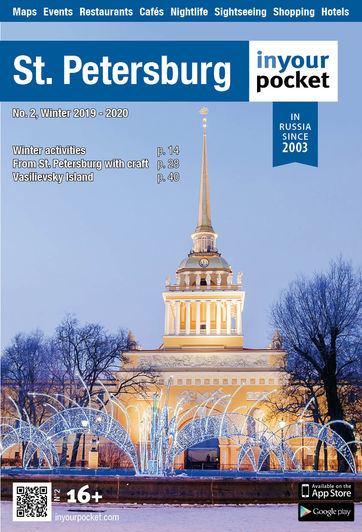Imperial Porcelain Factory
more than a year agoIt was here that D. Vinogradov, a talented Russian scientist, distilled the secret of the so-called “white gold”. He was the first in the history of ceramics to draw up the scientific description of the porcelain manufacturing process close to the latest concepts of ceramic chemistry.
Initially called the Neva Porcelain Manufactory, the factory made accessories for Empress Elizabeth who used them as presents for her attendants and diplomatic gifts. As soon as Vinogradov managed to construct a wide hearth in 1756, larger items became available and the first dinner set was made for Her Majesty.
After Catherine II took to the throne (1762–1796), the factory was re-organized and renamed the Imperial Porcelain Manufactory in 1765. The end of the ХVIII century is considered to be the “golden age” of Russian porcelain. The Imperial Porcelain Manufactory was one of Europe’s finest. With such grand dinner sets as "Arabeskovy", "Yakhtinsky" and "Kabinetsky" numbering up to a thousand items, the Imperial Porcelain Manufactory reached the pinnacle of fame.
During the reign of Alexander I (1801–1825), the manufactory was controlled by Count Dmitry Guryev, a trusted advisor of the Emperor. He initiated a major re-organization under the leadership of F. Guttenberger, Professor of Engineering in the University of Geneva. Count Guryev spared no expense in attracting the best local and foreign experts.
Russian porcelain not only glorified the deeds of the Emperor but also conveyed national ideas and attitudes. For example, the Guryevsky dinner set is an ode to the people who won the Patriotic War of 1812. This historical event also gave rise to a series of “war plates” depicting the soldiers and officers of all branches of the Russian military service. In addition, portrait painting was widely practiced in those days.
Vases played a special part in the manufactory’s output from the early years of Alexander I’s reign and till the 1860s. Gold became one of the most favorite decorative materials, while painting was dominated by landscapes and battle scenes. Palatial dinner sets were also an important product of the factory.
In the time of Nicholas I, porcelain stood out for its artful paintings. The vases displayed the old masters’ chef d’oeuvres (Leonardo da Vinci, Raphael, Titian, Correggio, Murillo, etc.) mostly from the Hermitage collection. The replicas are notable for their striking accuracy and refinement. The palette of pure and brilliant colors was in perfect accord with the originals. At the same time, portrait, icon and miniature painting on vases and panels also gained momentum. Awards at world fairs in London, Paris and Vienna consolidated the factory’s leadership in porcelain painting.
The Imperial Porcelain Manufactory celebrated its 100th anniversary by establishing its own museum in 1844. It included a fine display of exhibits from the Winter Palace collections.
After the failure at the 1900 Exposition Universelle in Paris, the Imperial Porcelain Manufactory came under the patronage of Empress Alexandra Feodorovna. In addition, a series of war plates depicting the troops of Alexander III and “The Peoples of Russia” series of sculptures designed by P. Kamensky were also made for Nicholas II. The sculptures are notable for their ethnographic accuracy.
In the mid 1900s, the Imperial Porcelain Manufactory started establishing contacts with members of the “Mir Iskusstva” (World of Art) artistic group, including Konstantin Somov, Eugene Lanceray and Sergey Chekhonin, who promoted Neoclassicism in the Russian porcelain-making tradition.
Following the Bolshevik Revolution, the Imperial Porcelain Manufactory was nationalized and renamed the State Porcelain Manufactory in 1918. It came under the control of the People's Commissariat for Education, which set a task to turn the former Imperial Manufactory into the “republican pilot laboratory of ceramics”, where propaganda porcelain in the highest sense of this word would be made, “revolutionary in content, perfect in its shape and flawless in workmanship”.
The porcelain of the 1920s is, probably, one of the most curious and surprising chapters in the history of applied arts. It preserved the atmosphere of the first years of the Proletarian Revolution in a perfect artistic form. Skilful artists worked under the guidance of Sergey Chekhonin, also known as the “master of the Soviet Empire style”. The porcelain of the 1920s is associated with artists like Kustodiev, Petrov-Vodkin, Dobuzhinsky, Malevich and Kandinsky.
The Leningrad Porcelain Manufactory was the first in the USSR to open an art laboratory in 1930s, when Soviet culture started taking shape. The artistic team headed by N. Suetin, an apprentice of Malevich, invented the new Soviet porcelain style in tune with the “socialist way of life”. The talented artists found a perfect expression for Suprematist ideas integrating the decorative touch typical of the "Mir Iskusstva" (World of Art) artistic movement with the realistic representation of nature.
Khrushchev's "Thaw" of the 1960s revived art slogans of the 1920s such as “Bring art to everyday life” and “Bring art to the production environment”. After the pompousness and excessive decoration typical of Stalin’s period, the interest in white porcelain, laconic design and simple shape was rekindled.
Nowadays, respect for heritage coupled with the continuous development and regular renovation of artistic traditions is still a hallmark of St. Petersburg porcelain school. This approach may be observed in the works by T. Afanasyeva and G. Shulyak, N. Petrova and O. Matveeva, M. Sorokina and S. Sokolova.
Each of them found their own style in the art of porcelain, contributing to the decorative diversity and emotional vividness of the Imperial Porcelain Manufactory’s products. Thus, the manufactory is still a place where the art of porcelain is born and nurtured on a daily basis.
/st-petersburg-en/museum-of-the-imperial-porcelain-factory_147731v
Since 2001 the Museum of Imperial Porcelain Factory has been run by the Hermitage’s management and today it boasts a stellar display of more than 30,000 …
/st-petersburg-en/imperial-porcelain-manufactory_9420v
One of the oldest European works, the Imperial Porcelain Manufactory established in 1744 by Empress Elizabeth, daughter of Peter I. It was originally an …





Comments